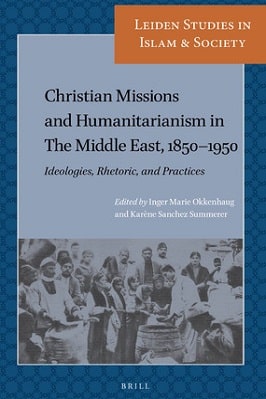
| Book Title | Christian Missions And Humanitarianism In The Middle East |
| Book Author | Inger Marie Okkenhaug |
| Total Pages | 316 |
| Book Views | |
| Language | English |
| Book Download | PDF Direct Download Link |
| Get Hardcover | Click for Hard Similar Copy from Amazon |
Christian Missions and Humanitarianism in the Middle East, 1850–1950- Ideologies, Rhetoric, and Practices Edited by Inger Marie Okkenhaug – Karène Sanchez Summerer
CHRISTIAN MISSIONS AND HUMANITARIANISM IN THE MIDDLE EAST
Book’s Introduction
During the Israeli-Palestinian War of 1947–1948, relief to Palestinian refugees was not only given by international agencies and non-governmental organizations. Aid also involved Christian mission institutions already historically present and active in the region.
This humanitarian reaction of the Christian missions towards people in need was, however, not a new phenomenon. The German Protestant Syrian Orphanage in Jerusalem for example was founded in 1860 as a response to the civil war in Syria the same year.
During the following decades, the orphanage developed into the largest missionary institution in the country. As shown by Roland Löffler, the Syrian Orphanage underwent a “silent metamorphosis” from a Protestant pietistic mission institution into a major undertaking of social service.1
This was a typical development in the Middle East, where many Christian missionaries supported welfare activities that involved ideas and practices of improving people’s lives, mostly presented as subservient to the preaching of Christianity.
Facing major obstacles in their attempt to convert locals, mission organizations increasingly shifted their focus from evangelization to health and education, frequently changing their vocation according to local demands.2
Furthermore, some ethnolinguistic minorities from the Middle East who had suffered displacement during World War I (particularly Assyrian and Armenian populations) saw the European sectarianization process of minorities3 as opportunities for some sort of local autonomy.
Linked to the large diaspora, they appealed to international Christian opinion and together with the emerging humanitarian organizations, like the Near East Relief and the Red Cross, their message was received by a Western audience who donated money to their cause.
This volume intends to trace the historical links between Christian missionaries, the roots of humanitarianism, its different modalities, their use of “humanitarian diplomacy”4 and local encounters in a Middle Eastern context, considered as fundamental in the history of religious and social politics in a Muslim environment, this particular field being “so connected with the present-day concerns”.5
The century considered, between 1850 and 1950, represents moments of colonization, war, and conflicts, all formative settings for humanitarian actions.6 During this time, Christian missions were seeking new ways to translate their understanding of Christianity, as seen at the World Missionary Conference in Edinburgh in 1910, which put forward a civilizing mission that sought to modernize the world.7
The social dimensions of Christian missions in the Middle East have been revisited in several important studies in the last ten to fifteen years.
These works, representing a profound change in approach, methodology, and sources, include Beth Baron’s The Orphan Scandal: Christian Missionaries and the Rise of the Muslim Brotherhood, Barbara Reeves-Ellington’s Domestic Frontiers: Gender, Reform, and American Interventions in the Ottoman Balkans and the Near East, 1831–1908, and Paul Sedra’s
From Mission to Modernity: Evangelicals, Reformers and Education in Nineteenth-Century Egypt.8 Even so, the humanitarian actions of Christian missionaries in the Middle East have not yet been studied thoroughly.9
Depending on the areas where they intervened, missionaries were frequently consulted on repeated forced migrations. Some were gatekeepers of colonial states, some also distanced themselves from them.
The missionaries considered in this volume are not a homogeneous group (some well connected, others more isolated, some international protagonists, some local workers, some obsessed by the nation-state idea, others not).
The case studies present various missionaries’ networks that, at times, acted simultaneously and on various scales, within a competitive landscape of charities.
Examining institutional and individual strategies within national and local contexts will clarify the motives and effects of Christian missions in delivering aid and thus contribute to a new understanding of the history of humanitarianism in the Middle East.
To read more about the Christian Missions And Humanitarianism In The Middle East book Click the download button below to get it for free
Report broken link
Support this Website
Click here to join our Telegram group for new Books